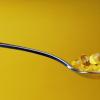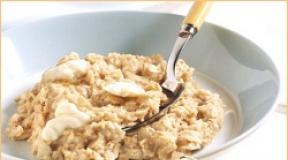Kefir and yogurt: how to choose a “live” product? Composition and shelf life. Live yogurt: nutrition for health Live yogurt
Drinking cold kefir on a hot day - what could be more pleasant! In the summer, it is no coincidence that our body strives for fermented milk drinks: they protect against intestinal infections and other digestive troubles that may occur during this season. But only products without preservatives are useful. We tell you how to choose the right yogurt and kefir.
Fermented milk products are obtained from milk or its derivatives (cream, whey) by fermentation with various starters in the form of lactic acid bacteria (thermophilic streptococcus, lactococcus, acidophilus and Bulgarian bacillus) and yeast. These foods help the body absorb nutrients, contained in milk, and have a beneficial effect on metabolism.
Sourdough contains 10 times more lactobacilli than is usually found in fermented milk products. Live lactic acid bacteria, when used regularly, strengthen the immune system and slow down the aging process of the body, and also remove radionuclides from the body.
Kefir
Classic kefir contains only milk and kefir grain starter. Shelf life of kefir- from 36 hours to 15 days. Fermented milk products with a shelf life of more than 20 days contain preservatives.
According to GOST, the number of lactic acid bacteria at the end of the shelf life of kefir should be at least 1 × 107 CFU/g, the number of yeast should be at least 1 × 104 CFU/g. CFU- colonies of forming units - living microorganisms, lactic acid bacteria. It is customary to indicate the number of CFU per 1 g.
How to choose kefir that is healthy for you?
- Kefir can be weak, medium and strong. This depends on its maturity - three-day kefir has more carbon dioxide and alcohol than one-day kefir. Strong kefir is the most active catalyst for digestive processes in the stomach and cleansing processes in the intestines.
- Kefir of different strengths has different effects on the intestines: fresh daily kefir weakens, three-day strong kefir strengthens.
- Strong kefir is not for everyone. For people who suffer from ulcers, pancreatitis or gastritis, kefir aged for three or more days is not useful.
- The packaging of real kefir certainly has the certification mark STP and GOST R 52093.
Other lactic acid drinks
A drink prepared with pure lactic acid microorganisms is a kefir product. Shelf life of kefir product- up to 20 days.
Biokefir is kefir enriched with bifidobacteria, microorganisms that activate metabolic processes. Biokefir is suitable even for people intolerant to cow's milk.
IN Ryazhenka contains a large number of beneficial bacteria that improve the functioning of the gastrointestinal tract and kidneys.
Acidophilus bacillus improves the digestion process and helps reduce blood cholesterol levels.

Yoghurts
Currently, three types of yoghurt are produced: natural yoghurt without fruit and aromatic additives, fruit or vegetable yoghurt and flavored yoghurt. When comparing natural and fruit yogurt, the advantages will be on the side of the former. Natural yogurt is a lactic acid drink, without heat treatment after fermentation, containing lactic acid bacteria.
Buy natural yogurt without sugar or fruit additives - it is not as boring as it seems. Add fruits or berries to it to suit your taste, stir - healthy and tasty designer yogurt is ready. Also, natural yogurt without sugar and fruit is suitable for dressing salads - it is an excellent replacement for high-calorie mayonnaise or sour cream.
Choosing yogurt
- Yogurts are divided into “live” (with active microorganisms and starter microbes) and those in which there are no bacteria. The former have a short shelf life, but they are healthy, unlike the latter, “long-lasting” yoghurts with a long shelf life. Do not take a product with a long shelf life; due to heat treatment, it does not contain beneficial bacteria. Shelf life of real live yogurt should not exceed seven days, provided that the yogurt is stored in the refrigerator at a temperature not higher than 7 ° C.
- High-quality yogurt contains milk (pasteurized and/or skimmed), a culture of lactic acid bacteria, and possibly pieces of fruit. In dessert yoghurts, cream, sugar or sourdough is added to this composition.
- Only those yoghurts that contain living cultures. The packaging should indicate their presence, for example, Lactobacillus bulgaricus, Bifidus and Lactobacillus acidophilus.
- Drinking yoghurts with pieces or juice of fruit may contain a lot of sugar. Therefore, people watching their weight need to be more careful in their choice.
- Part fruit yogurt includes natural fruits. To ensure that it has the desired texture, gelatin and stabilizers are added to it. Adding sugar significantly increases the calorie content of yogurt.
Discussion
I prefer ryazhenka
Yes, I heard that not all of our kefir says so, including drinking kefir. That's why I use fermented baked milk))
I wasn’t too lazy on purpose and went to the kitchen to get a packet of kefir so I could read what was written there. Judging by the article, it’s clearly not kefir in my refrigerator))) It’s a pity that it’s so difficult to find high-quality and tasty kefir in stores.
Comment on the article "Kefir and yogurt: how to choose a “live” product? Composition and shelf life"
Kefir and yogurt: how to choose a “live” product? We choose real kefir and live yogurt - composition and shelf life. What is CFU? ...they make problems and put candy on the table, children treat them calmly and do not prefer meat, fruit, yoghurt and others What...
The topic was created to discuss the article Kefir and yogurt: how to choose a “live” product? Composition and shelf life. Fermented milk drinks– in summer: choose healthy ones.
In total 5.3, in natural yogurt Activia is 6.3 (unsweetened, without fillers). The numbers are similar, the difference is 1 g, perhaps because yogurt also has more protein than milk, for example. What kind of coals these are, useful or not, I don’t know. I never thought about it, no...
Homemade yogurt!!! Yogurt makers.. Children's table. Cooking. Cooking recipes, help and advice on cooking, holiday menus and receiving guests, choosing products. A spoonful of natural yogurt and 8 hours. All. I take whatever is in the store.
The new Ehrmann yogurt contains prebiotics - natural plant substances. This is fundamentally different, more natural and effective method help digestion. Until now, no one in Russia has offered consumers a product...
I can cut an apple or pear into natural yogurt, sprinkle with pine nuts, a spoonful of honey - yum! Is it lazy in the yogurt maker? I think this should be funny. But in principle, the calorie content can probably be controlled.
Kefir and yogurt: how to choose a “live” product? Composition and shelf life. Kefir. Classic kefir contains only milk and kefir grain starter. 2. the milk should be cold (from the refrigerator) 3. if you put it on cow milk, then take it...
1/2 banana, mashed with a spoon, + a little natural cocoa. what else happens. refreshing summer cocktail - yogurt or kefir with fresh cucumber(in a blender), you can add a little salt and a couple of mint leaves. this is just for variety.
Tell me about food storage. - gatherings. Cooking. Culinary recipes, help and advice on preparing dishes, holiday menus and entertaining guests, food selection. Kefir and yogurt: how to choose a “live” product? Composition and shelf life.
Natural yogurt is a lactic acid drink, without heat treatment after fermentation, containing lactic acid bacteria. I give preference to natural ones without adding various artificial additives - kefir, fermented baked milk, cottage cheese, yogurt, etc...
Yogurts. - gatherings. Weight loss and diets. How to get rid of excess weight, lose weight after childbirth, choose a suitable diet and communicate with And you can also look at the drug store for the product “Narine”, from which kefir is made for children, they say, also an option for yogurt starter.
Kefir and yogurt: how to choose a “live” product? Composition and shelf life. Classic kefir contains only milk and kefir grain starter. The World Health Organization notes that probiotics are “live...
Kefir and yogurt: how to choose a “live” product? Composition and shelf life. The shelf life of real live yogurt should not exceed seven days, provided that the yogurt is stored in the refrigerator at a temperature not higher than 7 ° C.
harmful... it is better to find yoghurts or curds with a minimum shelf life; they either have no preservatives, or minimal content (not so long ago it was a miracle and agusha) and without dyes and sweeteners. Kefir and yogurt: how to choose a “live” product?
Kefir and yogurt: how to choose a “live” product? Composition and shelf life. Currently, three types of yogurt are produced. Yogurt is a magical product. Correspondents from all over the world who visited the Pasteur Institute in December and...
Not so long ago, some rules were adopted that only products containing the same yoghurt cultures can be called YOGURT. The word is similar, but not yoghurt. Because there is a clear standard for yogurt, what it should contain, in what quantity, living...
Kefir and yogurt: how to choose a “live” product? Composition and shelf life. To the content. Classic kefir contains only milk and starter culture. How to choose kefir that is healthy for you? Kefir can be weak, medium and strong.
Kefir and yogurt: how to choose a “live” product? Composition and shelf life. Classic kefir contains only milk and kefir grain starter. Of course, we never add anything to yogurt made from breast milk.8. Store the finished product in the refrigerator.
A product called yogurt must contain lactic acid bacteria. The shelf life of such a product cannot exceed 30 days and it should ONLY be stored in the refrigerator. It is better to drink natural yogurt.
Yogurts. . A child from birth to one year. Care and education of a child up to one year: nutrition, illness, development. And it seems that these same bacteria can live for a very short time, so yoghurts with a long shelf life do not contain them.
Jun-8-2016
What is yogurt:
Questions about what yogurt is, the benefits and harms of yogurt for the human body, and whether this fermented milk product has any medicinal properties, are of great interest to those who care about their health and are interested in traditional methods treatment. And this is understandable. Maybe the information below will, to some extent, answer these questions.
Yogurt is a fermented milk product with a high content of skim milk substances, produced by fermentation with a protosymbiotic mixture of pure cultures of Lactobacillus bulgaricus (Bulgarian bacillus) and Streptococcus thermophilus (thermophilic streptococcus), the content of which in the finished product at the end of the shelf life is at least 107 CFU (colony forming units ) in 1 g of product (addition is allowed food additives, fruits, vegetables and their processed products).
Real yogurt consists of natural milk and a starter containing cultures of Bulgarian bacillus and thermophilic streptococcus.
Wikipedia
Currently, in addition to kefir, there are a large number of various types yogurt. This drink appeared in Russia in the early 90s of the 20th century and, thanks to its excellent taste and nutritional properties, quickly gained popularity among domestic consumers. Today, this lactic acid product successfully competes with kefir and has noticeably displaced other fermented milk products.
This drink is made from whole cow's milk, which is pasteurized and thickened by adding milk powder or cream. As a result, it acquires a denser consistency than kefir and contains more protein and carbohydrates.
To ferment yogurt, a special mixture of Bulgarian bacillus (Lactobacillus bulgaricus) and thermophilic streptococcus (Streptococcus thermophilus) is used. These bacteria are an essential component of this drink and are very useful for the human body, and in their “live” form.
There are a large variety of yoghurts, but in general they can be divided into two main groups:
1) with live bacteria (“live” yogurt);
2) pasteurized (“non-living” yogurt, or yogurt product).
The “live” product contains live Bulgarian bacilli and thermophilic streptococcus, which actively suppress the growth of pathogenic microorganisms and help normalize the intestinal microflora, prevent constipation and dysbacteriosis.
Along with “live” yoghurts, “non-live” yoghurts are now widespread. They are stored much longer, but are much less beneficial for the body. The production of such a drink has its own peculiarity: milk is fermented, thickeners are added, and then subjected to heat treatment, “killing” live Bulgarian bacilli and streptococci. As a result, its medicinal properties sharply decrease, since they are precisely related to the presence of “live” cultures in this drink.
“Still” yogurt is an ordinary nutritious, easily digestible fermented milk product containing protein, vitamins and microelements.
The real thing is not subjected to heat treatment. This is the main difference, and you should definitely pay attention to it when purchasing.
By what signs can you distinguish a natural product from a yoghurt product?
“Live” (natural) yogurt:
- storage period – no more than 30 days;
- storage temperature – from 4 to 6 °C. In stores it is in the refrigerator;
- on the top of the package it is written large: “Yoghurt”;
- contains yoghurt starter;
- The content of lactic acid microorganisms is usually indicated.
Yogurt product (“non-living” yogurt):
- shelf life – 3 months;
- storage temperature – from 4 to 25 °C;
- on the top of the package, instead of the word “Yogurt”, it is written: “Yogurter” or “Biogurt”;
- on the side it says: “Terminated yoghurt product”;
- There is no yoghurt starter in the composition.
Depending on the degree of fat content, yogurts are divided into milk, milk-cream and cream.
Dairy drinks contain up to 4.5% fat, and they, in turn, are divided into low-fat (0.1%), semi-fat (1.5–2.5%) and classic (2.7–4.5%). ) yoghurts. The fat content of milk and cream is from 4.5 to 7%, and that of cream is at least 10%. The higher the fat content, the higher the calorie content. Sometimes hydrogenated vegetable fats are added to this drink: palm or coconut oil.
There are also simple and complex yoghurts containing various additives (fruit, vegetable yoghurts, as well as those containing whole grains, flavored).
Plain yogurt does not contain any additives (including sugar, starch, gelatin, stabilizers). This drink is the most useful, as it contains the maximum amount of yogurt base.
Beneficial features:
This lactic acid product is digested human body much better and lighter than milk. Many people who are lactose intolerant can consume it without problems. The fact is that under the influence of living cultures, a special enzyme appears in the product - lactase, which is not found in the body of people suffering from lactose intolerance. And the enzyme beta-galactosidase helps to absorb milk sugar more efficiently. The enzymes contained in yogurt contribute to the partial processing of milk, making the product less allergenic.
This lactic acid product helps our intestines stay healthy. Lactobacilli stimulate intestinal function, reducing the risk of colon cancer. In addition, lactobacilli contribute to the colonization of the large intestine with beneficial microflora, which also reduces the risk of developing malignant tumors. Beneficial bacteria in the drink block nitrites and other harmful substances before they turn into carcinogenic metabolites.
This lactic acid product is a source of calcium, a microelement that also reduces the risk of colon cancer (when consuming 1.2 mg of calcium per day, the risk of tumors is reduced by 75%).
This lactic acid product strengthens the immune system. With daily consumption of yogurt, the body begins to intensively produce interferon, which helps in the fight against viral infections.
Eating yogurt is recommended for people who have suffered acute viral diseases and intestinal infections. The fact is that some viral infectious agents can damage the intestinal mucosa, especially the cells responsible for the production of lactase. As a result, transient intestinal dysfunction occurs and the ability to absorb lactose decreases. Since this drink promotes the production of lactase, it is recommended to drink it during and after illness.
This lactic acid product must also be consumed when taking antibacterial drugs. Antibiotics suppress not only pathogenic microflora, but also have a detrimental effect on the normal intestinal microflora. The live bacterial cultures contained in it restore the intestinal microflora before pathogenic agents and fungal infections begin to multiply there. Taking such a product every day during antibiotic therapy significantly reduces the risk of developing intestinal dysbiosis.
This lactic acid product is also able to suppress fungal infection. Eating yogurt daily reduces the risk of developing a fungal infection.
This lactic acid product is a rich source of protein. Two cups of natural yogurt contain 20% daily norm squirrel.
If you choose between milk and yogurt, you should give preference to the latter, since, firstly, it contains more protein, and secondly, due to the transformation and partial processing of milk protein, it is better absorbed.
IN Lately A version has emerged that yogurt can lower blood cholesterol levels.
This lactic acid product is equally useful for young people, children and the elderly. For children it is a tasty source of proteins, fats and carbohydrates. For older people, yogurt is a soft product that protects the intestines from negative agents. For young active people - tasty and useful product, helping to maintain vitality.
When choosing between store-bought and homemade natural yogurt, you should, of course, choose the latter. Homemade - does not contain sugar, stabilizers, flavor enhancers, or preservatives. In addition, it is lower in calories, richer in calcium, and has 2 times more protein than its factory counterpart.
This drink is a universal product: it is both a separate dish and a sauce; it can even replace mayonnaise. Natural yogurt, compared to mayonnaise, contains 3% less cholesterol, 1% less fat and, of course, it is lower in calories. This fermented milk product can replace sour cream, cream, and milk. A chilled whipped drink can easily replace ice cream.
100 g of yogurt contains proteins, fats, carbohydrates, vitamins A, B1, B2, B3, B6, B12, C, PP, choline, iron, potassium, calcium, magnesium, sodium, sulfur, phosphorus, chlorine, iodine, cobalt, manganese , copper, molybdenum, selenium, fluorine, chromium, zinc.
It must be remembered that this lactic acid product spoils quickly, so it must be stored in the refrigerator and consumed immediately after preparation.
Based on the book by A. Antonova “Homemade cheese, cottage cheese and yogurt. We do it ourselves."
Contraindications:
The main reasons for the ban on including yogurt in people’s diets may be individual intolerance to its components or gastritis in the acute phase.
Can a fermented milk product such as yogurt negatively affect the functioning of the body? Yes, if it is not natural. Only live fermented milk products with real lactobacilli will benefit the human body. You can recognize them by their expiration date - for a natural product it is no more than one week.
Often, troubles when eating yogurt are associated not with the product itself, but with additional components in its composition (colors and flavors, sweeteners and thickeners), which is why it is necessary to give preference to natural yogurts without food additives. It is important to carefully read the information on the label before purchasing or prepare it at home yourself.
How to make yogurt at home:
This lactic acid product can be prepared at home from boiled or pasteurized milk. It is not recommended to use fresh milk, as it may contain foreign impurities and bacteria.
As a starter, you can use store-bought yogurt (“live” or probiotic) or dry yogurt culture, which can be purchased at a pharmacy. You can then use part of the drink you have already prepared as a starter, but it must be updated periodically.
There are several simple and affordable ways to make yogurt at home.
Preparation using “live” starter:
To do this, you will need 2 liters of whole milk and 50 ml of store-bought fresh “live” yogurt. Bring the milk to a boil, then remove from the heat and cool to 45°C. In this case, the pan with milk can be placed in cold water. The ideal temperature for yogurt bacteria is 43–45 °C. Pour out a small amount of milk, mix it with yogurt, add to the remaining milk and mix well. Cover the pan with a lid, wrap it in a terry towel and place it near a heat source for 4–8 hours. During this time, do not move the pan. Place the finished yogurt in a clean glass container, seal and place in the refrigerator, where it can be stored for 3-4 days. The resulting yogurt should have a homogeneous, jelly-like consistency, creamy white color, pleasant taste and smell.
Preparation using dry starter:
You will need 1 liter of skim milk and 1 packet of dry yoghurt starter. Sourdough starter can be purchased at pharmacies or health food stores.
Heat the milk to a temperature of 40–45 °C, add the yoghurt starter and mix thoroughly with a mixer. Cover the pan with a lid, wrap in a terry towel and place near a heat source to ripen. After 6–8 hours, the drink will be ready for consumption.
Yogurt makers:
If you are the happy owner of a yogurt maker or multicooker with the “Yoghurt” or “Multicook” mode, then the process of preparing a healthy product will be simplified several times for you, since you will not have to independently monitor the temperature when preparing it and look for a warm place in the room to stand yogurt.
A yogurt maker is a fairly simple household appliance, the action of which is aimed at maintaining a certain temperature. required quantity time. In order for milk bacteria to multiply intensively, the temperature of their environment should be in the region of 37-40 degrees. This is the mode that is maintained in the yogurt maker for the 6-10 hours required to prepare the product.
You don't have to worry that the product will cool down or, conversely, overheat. The smart device will do everything on its own and will consume very little electricity - after all, it will only work directly from the network for about an hour.
The housewife only needs to select the starter and milk, pour the liquid into jars and turn on the device.
Where to buy sourdough:
Yogurt starter is a set of bacteria for preparing this product at home. Its properties greatly depend on which bacteria are involved in fermentation.
There are many different starter cultures for yoghurt, and they differ not only taste qualities final product, but also the degree of benefit brought. Sourdoughs that contain more varieties of beneficial bacteria are considered the most beneficial.
Sourdough can be purchased at a pharmacy. Here are the following starters for making yogurt at home:
Sourdough "Evitalia"
This starter contains not only more than four billion bacteria, but also vitamins (A, B1, B2, B6, B12, C, E) and microelements (iron, calcium, magnesium). Yogurt based on Evitalia starter culture has a delicate taste, pleasant thickness, and is not sour, so children really like it. It is also known that yogurt made from Evitalia ferment contains antioxidants, and therefore prevents the aging of the body.
Sourdough (enzyme) “Narine”
Narine sourdough has proven itself excellent in pediatrics due to the fact that, in addition to ordinary lactobacilli, it contains acidophilic lactobacilli, which have an excellent anti-inflammatory effect, have a beneficial effect on the immune system and relieve dysbacteriosis.
Bifidumbacterin
The well-known bifidumbacterin (dry biomass of bifidobacteria) can be used as a starter; yogurt based on it can be given even to newborn children. It perfectly restores the intestinal microflora and has a beneficial effect on the entire body.
In addition, bacterial starters of the VIVO brand are very popular; depending on the specific variety of starter, it contains bifidobacteria and lactobacilli, and the taste is reminiscent of delicate homemade fermented baked milk.
Sourdough for making homemade yogurt costs approximately 180-240 rubles. However, many people choose dry sourdough. What is this connected with? The fact is that if you choose a low-quality starter (expired, containing dyes, preservatives, etc.), you will not get real yogurt and will spoil a large amount of milk. As for dry yogurt starter, it is quite difficult to spoil the raw materials. In addition, it is not necessary to purchase an enzyme every time. The starter must be prepared once and then stored in the refrigerator for about 2 weeks.
 Yoghurts can be “live” or “non-live”. When visiting grocery stores, we pay attention to the label and new products that tempt us with our appearance and a variety of fillers.
Yoghurts can be “live” or “non-live”. When visiting grocery stores, we pay attention to the label and new products that tempt us with our appearance and a variety of fillers.
The new names are confusing, and the composition is completely incomprehensible. Today we will try to figure out what benefits yoghurts bring and how to choose a quality product.
Yogurt is a fermented milk product, but is characterized by increased low-fat dairy substances. The product is prepared by fermenting Bulgarian bacillus and thermophilic streptococcus.
Low-fat substances mean protein and carbohydrates; they provide high energy and nutritional value.
Like non-live yoghurts, live yoghurts are prepared from the first grade of cow's milk, after which it is pasteurized and aged to ensure that all microbes are killed.
After it has settled, it is whipped and cooled, while adding sourdough. Some manufacturers add probiotics, because they are especially beneficial for our body. The yogurt is then thickened and packaged sterilely.
The shelf life of live yoghurts is usually no more than two weeks.. The most honest and caring manufacturers make yoghurts with a shelf life of a week. They are the most natural. 
The preparation of yoghurts with a non-living structure occurs in the same way as in the case of living ones.
After adding starter culture, thickeners, coloring agents and preservatives, the yogurt is subjected to additional heat treatment. This destroys all beneficial bacteria.
This is done so that the yogurt can be stored much longer. Typically, non-live yoghurts can be stored for up to three months.
Such a product has no beneficial substances, but only a high calorie content due to the high content of sugar and food additives.
Unfortunately, yoghurts of this composition occupy almost leading positions in sales. Young mothers often make the mistake of buying their babies this inherently useless product.
It is better to remove non-living yogurt from the list altogether baby food and replace it with a live one. Products containing probiotics should be constantly present in the children's diet.
The active organisms in their composition - lacto and bifidobacteria - have an excellent effect on the microflora, protect against infections and perform many other necessary actions.
So, if you want to saturate your body only useful substances, That the choice should be directed towards live yogurt.
How to choose the right live yogurt
1) Pay attention to the label first. It will be better if the composition contains no more than two or three ingredients. Manufacturers usually note the presence of lactic acid bacteria and milk that has been pasteurized.
2) Secondly, it is better to choose yogurt that contains at least three hundred milliliters of calcium for every gram of product.
3) The calorie content of the dairy product we are studying must be no more than two hundred and fifty KCAL.
4) The label should also state that the yogurt contains live cultures.. Precisely living - if it is written “based on living ...”, this most often indicates that the product was alive before strong heat treatment, after which it became inanimate.
 5) According to accepted standards, real fermented milk yogurt should not be re-leavened.
5) According to accepted standards, real fermented milk yogurt should not be re-leavened.
Do not buy products that indicate that they have been heat-treated, and do not forget about the shelf life.
This period is no more than one week. If the shelf life has been exceeded, but the technical information states that it is supposedly “live” yogurt, you should not fall for the manufacturer’s scam and buy a useless product.
6) Close attention should also be paid to the presence of the amount of biocultures. Their content should not be less than 107 colony forming units (CFU) per gram of product.
It is best to purchase yoghurts for your child at a pharmacy, then the likelihood of getting a quality product will be higher, and there will be more benefits for the body.
Also, we should not forget that you can prepare yogurt yourself, following all sorts of recipes. A homemade product will be tasty and healthy not only for your body, but also for your growing baby.
Eat only natural foods and get the maximum dose of health!
Yogurt appeared on the shelves of our stores only 20 years ago. This useful product was immediately loved by children and adults. In fact, yogurt has a long history, and its production was put on an industrial basis by the future founder of the Danone company in Spain at the beginning of the 20th century. At first, yogurt was sold only in pharmacies, and later appeared in grocery stores.
Homemade yogurt - benefits
It has long been known that yogurt is healthy. But scientific confirmation of the life-giving properties of yogurt products was obtained much later - at the beginning of the 20th century by our compatriot I. I. Mechnikov, who discovered the relationship between aging and digestion. The scientist noticed that in Bulgaria many people live to a ripe old age - many are long-livers. While studying the diet of Bulgarian peasants, Mechnikov noticed that a significant part of their diet was occupied by yoghurt-like and fermented milk products.
Continuing to deeply study this topic, the scientist found out that the reason early aging and various diseases is the destructive effect on the body of toxins - waste products of foreign microorganisms. Subsequently, this theory received serious development. The role of intestinal microflora has been carefully studied, after which scientists have concluded that the medicinal bacteria contained in its composition have an important purpose:
- neutralize toxins;
- participate in the process of digesting food and complete absorption of nutrients;
- promote the absorption and processing of proteins;
- normalize and maintain normal intestinal motility;
- improve the absorption of vitamins;
- strengthen immunity - the body's resistance to infections;
- prevents the development of dangerous pathogenic flora in the intestines.
The delicate balance of intestinal microflora can be disturbed very easily, leading to the rapid death of beneficial bacteria and the uncontrolled growth of pathogenic organisms. This phenomenon is called dysbiosis, which is usually the root cause of more serious diseases, including ulcers, kidney and liver diseases, gastritis, colitis, constipation and diarrhea. Dysbacteriosis can be cured by regularly consuming fermented homemade yoghurts with live bacteria, and making yoghurt at home is very simple.
What beneficial bacteria are included in homemade starter yogurts?
Beneficial bacteria included in live yogurt:
Bulgarian stick
Yogurt acquires healing properties thanks to a valuable bacterium - the Bulgarian bacillus. Lactobacilli (Bulgarian bacilli) are able to ferment milk at a temperature of 40-45°C and maintain their viability not only in yogurt, but also in the intestines, suppressing pathogenic bacteria and preventing putrefactive processes and gas formation.
Acidophilus bacillus
The peculiarity of acidophilic bacteria is that they retain their vitality even in the absence of lactose, are resistant to alkalis, and therefore take root well in the intestinal microflora. They have antibiotic properties - as a result of their vital activity they form antibiotics: nisin, streptocin, lactolin, diplococcin, which have a detrimental effect on pathogenic microorganisms.
Probiotics
Bifidobacteria occupy 80-90% of the infant's intestinal microflora. They actively participate in the processes of suppressing harmful microorganisms and digesting carbohydrates. As a result of their life, they form: lactic and acetic acids, natural antibiotics, B vitamins. Probiotics, also known as bifidobacteria, help improve immunity and reduce the risk of the formation of malignant cancer tumors.
Why is homemade yogurt healthier than milk?
The value of yogurt is due to both the presence of live lactic acid bacteria and the presence of all useful properties milk. And milk is the most valuable dietary product, the main source of calcium, animal proteins, etc. However, for some time now, the benefits of milk for the body of adults have begun to be questioned, since with age, a person supposedly loses the ability to digest lactose contained in milk (but this is a controversial issue). In any case, in yogurt, lactose under the influence of lactic acid bacteria is converted into lactic acid, which makes this product easily digestible. Thus, natural yoghurt, preserving everything valuable properties milk, without its disadvantages.
Homemade yogurt is the best dietary product
Regular consumption of yogurt improves metabolism by activating metabolic processes. helps get rid of overweight also for a reason high content calcium, which has been shown to promote weight loss. This is a low-calorie product that helps you quickly achieve a feeling of fullness, therefore it is the basis or part of many diets. In order for yogurt to really bring benefits, it is better to prepare yogurt at home.
Methods for making yogurt at home - recipes
It is not advisable to use fresh milk to make high-quality yogurt, as it may contain harmful bacteria. For the same reason, it is necessary to thoroughly sterilize or scald with boiling water all containers in which yogurt will be prepared, as well as spoons and lids. To make yogurt, it is convenient to buy pasteurized milk in a tetra pack, but you can boil it and cool it homemade milk on one's own.
Method one - how to make homemade yogurt in a pan from store-bought “live” yogurt
- 2 liters of milk;
- 50 ml of “live” yogurt purchased in a store;
- pan and terry towel.
So, how to make homemade yogurt:
- Bring the milk to a boil and cool under the lid to a temperature of 45°C.
- Pour some milk into a separate sterilized container and combine it with store-bought yogurt.
- Add this mixture to the pan with milk and mix thoroughly.
- Cover the pan with a lid, wrap it in a terry towel and leave in a warm place to ripen the product for 6-8 hours. During the period of time when the yogurt is ripening, the pan should not be moved.
- When the yogurt is completely ripe, transfer it to pre-sterilized jars and place them in the refrigerator.
- Remember that the shelf life of homemade yogurt is up to 5 days. It can also be used as a starter for making yogurt in the near future, but keep in mind that the starter needs to be renewed periodically to avoid degeneration of lactic acid cultures.
Method two - a recipe for making homemade yogurt in an improvised yogurt maker from homemade starter
As an improvised yogurt maker, you can use a large saucepan with a lid, preferably with thick walls and a bottom, in which you can prepare a homemade yogurt recipe in a water bath.
- 1 liter of milk;
- 70 ml of previously prepared sourdough (see previous recipe);
- large saucepan with lid;
- terry towel for wrapping the pan;
- glass jars with lids.
- Sterilize the milk, jars and spoon you will use to stir. Cool the milk to 45°C.
- Spoon the starter into the jars, pour warm milk into the jars and stir.
- Cover the jars with lids and place them in the pan.
- Carefully fill the jars up to the hangers with water heated to 47-50°C.
- Remove the lids from the jars, but cover the pan with a lid and wrap it with a terry towel.
- Leave the yogurt to mature for 6 hours, then transfer the sealed jars to the refrigerator.
- Now, if desired, add fruit, condensed milk, jam, muesli, honey, chocolate, raisins, dried apricots, prunes, etc. to the yogurt.
Method three - a recipe for making homemade yogurt in a thermos from dry yogurt starter
- 1-3 liters of pasteurized milk;
- 1 packet of starter;
- thermos, preferably with a wide neck.
- Pour boiling water over the inside of the thermos and the stopper, hold the boiling water inside the thermos for several minutes with the lid closed.
- Heat the milk to 47°C.
- Pour a little milk into a thermos, dissolve the starter in it, close the thermos and shake it thoroughly for better mixing.
- Add the remaining milk to the thermos, close the lid, shake again and leave for 6 hours.
- Remove the yogurt from the thermos and place it in the refrigerator.
It is recommended to eat yogurt only after cooling, since only then does it acquire the necessary consistency, and the cold stops the processes of its fermentation. Do not eat yogurt if it looks suspicious: it has risen to the top, but liquid, a greenish tint, or foam remain at the bottom - bacteria dangerous to the body have multiplied in such a product.
Method four - recipe for making homemade yogurt in a yogurt maker
The easiest way to make homemade yogurt is in a yogurt maker.
- Scald the jars and lids.
- Heat the tetra pack with milk in a water bath.
- Open the bag of dry starter.
- Pour the contents of the sachet into a tetra pack.
- Close the lid and shake well.
- Now pour the milk with the starter into jars.
- Close them loosely and place them in a plugged-in yogurt maker.
- After 6-7 hours, it must be turned off and the jars moved to the refrigerator.
Method five - recipe for making homemade yogurt in a slow cooker
Making homemade yogurts in a slow cooker is just as easy as preparing them in a yogurt maker. It all depends on the specific model of the multicooker: some models have a yogurt function, in others you can independently turn on the desired temperature mode.
Pour the future yogurt directly into the multicooker saucepan - in this case, do not forget to scald it first.
Another option is to cook yogurt in jars in a water bath - in this case, place the jars on a piece of cloth to avoid damaging the Teflon surface of the pan.
- Turn on the required temperature mode: “Heating” (40-45)°C or “Yogurt”.
- Set the timer for 6-8 hours.
- Close the lid of the multicooker and go about your business.
- After 6 hours, transfer the yogurt to the refrigerator.
Legends have been made about the benefits of fermented milk products almost from the very beginning of humanity. Nowadays, a large selection of such products can be found in any supermarket. Perhaps the healthiest among them is yogurt. It contains vitamins, proteins, calcium, phosphorus, proteins, but most importantly, yogurt is considered a champion in the content of lactobacilli - the most beneficial bacilli, the presence of which in our body is extremely important. Bacteria can be of only two types - Lactobacillus bulgaricus (Bulgarian bacillus) and Streptococcus thermophilus (thermophilic streptococcus), and their content in 1 g of product must be at least 10 to 7 CFU (colony-forming units).
Today, most dairy product manufacturers “sin” by adding preservatives to their products that kill beneficial lactobacilli. Of course, such a product cannot be beneficial. What if you make it alive?
About a hundred years ago, Professor Mechnikov made one important discovery. If milk is fermented with these very lactobacilli and left in a warm place, the resulting product has pronounced healing properties that have a positive effect on the general condition of the body. In particular, daily consumption of yogurt helps improve metabolism, digestion, cleanse the intestines of waste and toxins, normalize stools, maintain the balance of intestinal microflora, which is very important for strong immunity and even weight loss. But they are truly useful only with a live culture of lactobacilli.
What distinguishes homemade natural yogurt from store-bought?
- This yogurt contains no dyes, flavors, thickeners or other additives, which domestic manufacturers are often too keen on. These elements are known to accumulate in the body, which ultimately has a detrimental effect on health;
- You can always create to your own taste by adding your own additives to the yogurt and getting wonderful desserts that children will adore. In addition, this yogurt is not initially sweet, so it can even be used for salad dressing, combined with salt and other seasonings;
- You can prepare it every day; its lifespan is very short, since the life of the beneficial bacillus is a maximum of five days.
- The calorie content of the drink can be whatever you wish and is equal to the calorie content of the original milk.
What you should pay special attention to when preparing natural yogurt at home:
- Milk for yoghurt should always be boiled! The fact is that raw, unpasteurized milk contains its own bacteria, the growth of which also increases with heat, and they suppress the beneficial lactobacilli of the starter culture.
- Yogurt must be prepared exclusively at a temperature of 36-40 degrees; it is believed that this is the optimal temperature for reproduction. If the milk overheats, it will simply curdle; if its temperature is lower, the yogurt will turn out “snotty.”
- Do not move the container during fermentation!
- The fat content of the starter does not affect the fat content of the resulting product. It just depends on the milk you will be “converting” into yogurt.
- The finished yogurt is a tender, slightly viscous mass that falls off in loose pieces from the overall mass.
- Preparing live natural yogurt at home takes just a few minutes, then wait six hours, and the drink of the gods is ready!
A few words about tools...
If you have a yogurt maker or a thermos with a wide neck, you are the owner of wonderful devices, because they are ideal for preparing a live drink. What about those who don’t have them? We use “grandmother’s” methods! Take a three-liter jar, wrap it several times with newspapers and a terry sheet. Homemade thermos is ready! And if it’s summer, then you can even put a “naked” jar on the windowsill in the sun, but be sure to monitor the processes taking place in it. The top of the jar can be covered with a plastic lid.
How to make it live natural yogurt at home. Recipes
Create this delicious drink It’s very simple, you just need to follow the right technology. The only products you will need are good milk, purchased, say, from a home manufacturer, and a special starter. The latter is sold at the pharmacy, for example, Narine, Danone, VIVO, Good Food or any other. Even store-bought, but very high-quality yogurt (50-70g) will do. If the milk is already pasteurized, then heat it to 36..40 degrees. If raw, boil first, then cool to this temperature.
Now add the starter to the milk and mix everything well. One bag is enough to ferment 1 liter of milk. To prepare the next yogurt, 50g of this mass can become a starter, but this can be done no more than three times. Some diligent housewives use a blender to mix milk and sourdough, but this is not recommended to avoid the death of beneficial lactobacilli. Pour the mixture into the “dishes”, close it, and after six hours you will receive a magnificent product, useful in all respects and quality!
As you can see, making natural yogurt at home is not difficult. Use live yogurt immediately after preparation. The lack of sugar can be compensated by your favorite fruits or berries. By adding syrup or juice to yogurt in addition to fruit, you can get delicious smoothies and desserts in various interpretations.
And if you mix a spoon with half a glass of yogurt soy sauce and dress the salad, I guarantee you will love the taste of this dish. Bon appetit!
You can read about another healthy fermented milk product, kefir, here.
To main
Who would have thought that preparing live yogurt at home is an absolutely simple task, for the preparation of which you do not need to have any special equipment or withstand difficult technological process. I myself have recently begun to cook it often, as it is in great demand among households, and most importantly, it gives me confidence that this product is natural and benefits my loved ones. Some may not understand me, why bother if you can buy a ready-made one in any store. In fact, it's really worth considering making your own yogurt. At least because:- you get healthy yogurt with live bacteria
- you can control its composition - in homemade yogurt you will not find thickeners, dyes, flavors and other unnecessary things that can cause best case scenario allergies
- you can control its freshness - thanks to the absence of preservatives, you will not consume a product made a month ago
- you can control its taste - choose different fillings yourself, experiment, and not be content with the standard taste set of mass-produced yogurt
- If your child (or adult) is intolerant to cow's milk, you can make yogurt with goat's or sheep's milk
- It doesn't take long to make your own yogurt
- Finally, during the cooking process you can come up with new recipes, for example, how to make ice cream from yogurt or an unusual sauce for salads, meat, etc.
As for the equipment, here you can use the means at hand - glass jar, saucepans, thermos, yogurt maker, multicooker, bread maker (yes, I was surprised when I learned that there are bread makers with the function of making yogurt). I can’t say for sure, but it seems to me that the equipment does not affect the quality finished product, since the cooking technology itself and the ingredients remain unchanged. It (the equipment) only simplifies the process and allows you to prepare and store the product in portions. Of course, preparing yogurt in a yogurt maker is easier and much more convenient than running around with a pan that needs to be heated, wrapped, etc. But this does not mean that it will not work out in the pan or will be tasteless.
Making yogurt at home, as I already wrote, does not take much time. You just need to boil the milk, cool it to 40 degrees (no more), pour the contents of a packet of starter into it (or add 50-70 grams of ready-made yogurt) and let it sit warm and quiet for about 8 hours. I cook yogurt in a slow cooker - I won’t go into details in this article, if you are interested, you can read yogurt in a slow cooker on the forum step by step recipe with photo. Better yet, let me tell you how to make frozen yogurt or frogurt - a natural and tasty dish.
So, grind the berries in a blender, add yogurt, homemade cheese, low-fat sour cream, powdered sugar. You can add some whole berries. Place this in a container and freeze in the freezer, stirring a few times during the freezing process. Voila!



















